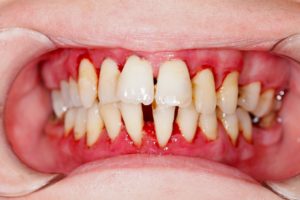 Gum disease can wreak havoc on your oral health without the right treatment. Although it is preventable, the infection is the leading cause of tooth loss. You don’t have to lose teeth from the infection. Your periodontist can save your smile and reverse the damage with gum disease therapy. Besides a deep cleaning and antibiotic therapy, your periodontist may also recommend gum grafting. Don’t worry about a painful procedure. Here’s what you can expect during the road ahead.
Gum disease can wreak havoc on your oral health without the right treatment. Although it is preventable, the infection is the leading cause of tooth loss. You don’t have to lose teeth from the infection. Your periodontist can save your smile and reverse the damage with gum disease therapy. Besides a deep cleaning and antibiotic therapy, your periodontist may also recommend gum grafting. Don’t worry about a painful procedure. Here’s what you can expect during the road ahead.
What is a Gum Graft?
A gum graft is a minor surgical procedure used to cover exposed tooth roots, which is a common complication of advanced periodontitis. This protects their surfaces from decay and seals out bacteria while creating a more aesthetically pleasing gum line. Your periodontist can take tissue from a donor or another area of your body to cover the tooth roots. Although it involves minor oral surgery, your periodontist will strive to keep it as pain-free as possible.
After examining your mouth and learning more about your concerns, they’ll recommend a specific grafting procedure to rehabilitate your smile, which can include:
- Connective tissue graft
- Free gingival graft
- Pedicle graft
Is Gum Grafting Painful?
Your periodontist will use a local numbing agent to prepare the surgical areas for the procedure. In some cases, sedation can also be used to keep you comfortable as they perform the surgery. You won’t feel any discomfort as your gum line is restored, but you can expect minor soreness as the effects of any anesthetics or sedatives dissipate.
Your periodontist may prescribe a pain medication to manage your discomfort while your mouth heals. They’ll recommend a few precautions over the next couple of weeks to ensure a quick, comfortable recovery, such as:
- Don’t place gauze on top of the surgical site. Instead, place it on either side of the surgery location to control any bleeding.
- Don’t exercise for at least 24 hours after surgery because it can increase blood flow, which can lead to painful gums.
- Avoid hot, cold, spicy, and acidic foods and drinks to avoid irritating the healing tissue.
- Stick to softer foods for a few days. Avoid biting into anything to prevent injuring the surgical sites.
- Carefully brush and rinse your mouth the day of surgery.
- Use a mouthrinse 24 hours post-op to kill bacteria.
- Use gentle movements when cleaning near the graft with your toothbrush.
- Don’t run your tongue over the tissue.
Repair Your Smile with Gum Grafting
No one enjoys a painful dental appointment, but you don’t have to fear your periodontist with needing gum grafting. You’ll benefit from a virtually pain-free procedure to improve your gum health.
About Dr. Rob Wood
Dr. Wood earned his dental degree from the Temple University in Kornberg School of Dentistry before continuing his education in periodontics. As a board-certified periodontist, he can treat the most complex oral health issues using advanced procedures, like gum grafting. If you have exposed tooth roots, don’t wait. Contact our office today to schedule your consultation for gum grafting.
